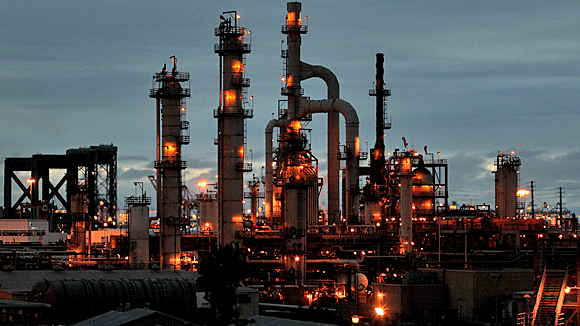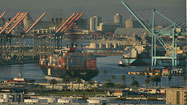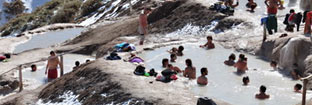
California's cap-and-trade program aims to limit greenhouse gases from industrial plants such as oil refineries. (Christina House / For the Los Angeles Times) |
The complex market system for the first time puts a price on heat-trapping pollution by allowing California's dirtiest industries to trade carbon credits. The rules have been years in the making, overcoming legal challenges and an aggressive oil industry-sponsored ballot initiative.
The air board met in Sacramento for more than eight hours in a packed hearing room. Board members listened to sometimes scathing comments from union workers fearful of losing their jobs and a parade of industry representatives who likewise characterized the regulations as anti-business. Other speakers called the proposal historic and groundbreaking.
Late in the day, as the eight board members voted to approve the regulations, to scattered applause, Chairman Mary Nichols looked up and said, "We've done something important."
"Cap-and-trade is a new tool that for the first time allows us to reward companies for doing the right thing," she added.
Cap-and-trade is the centerpiece of AB 32, California's historic climate change law that mandates a reduction in carbon pollution to 1990 levels by 2020. Beginning in 2013 the state's largest carbon emitters will be required to meet the caps or buy credits if they cannot.
A second phase of compliance begins in 2015 and is expected to include 85% of California's emissions sources.
Former Gov. Arnold Schwarzenegger, a strong supporter of the original legislation, applauded the vote in a statement released Thursday evening.
"Today's adoption of a cap-and-trade program is a major milestone for California's continued leadership on reducing the world's greenhouse gases. As I said both when we signed the legislation in 2006, and when we fought to protect it last year when Texas oil companies attempted to overturn it with Proposition 23, the most critical phase in the fight against climate change is diligently, aggressively, and correctly implementing this law."
The vote was closely watched by other states and, if the program is deemed successful, it will likely serve as a model for future markets. The U.S. Congress has rejected a similar national program.
"If California gets it right, others will see it's possible to regulate greenhouse gas emissions while protecting its economy and while fostering a new green economy and industry," said Gary Gero, president of the L.A.-based Climate Action Reserve, a nonprofit that runs North America's largest carbon offset registry. "People watch what California does and do emulate it. Future cap-and-trade programs are going to pick up a lot of the design features we are implementing here. You'll see regional programs develop. They will put pressure on the federal government. It will send out ripples around the country."
Many of the details of the cap-and-trade mechanism have changed since the board adopted the plan in 2008.
Industry heavyweights sought to temper some of the policy's more stringent requirements and succeeded in some cases. In March a judge ordered the air board to more comprehensively analyze alternatives to the market-based trading system, such as a carbon tax or direct regulation. The board in August adopted a revised analysis.
Environmental justice groups oppose aspects of the program, arguing that cap-and-trade's market allows refineries, power plants and other large-scale facilities to continue polluting poor neighborhoods as long as they purchase credits or offsets.
Explaining California's cap-and-trade program
How does cap-and-trade work?
Emissions caps were established by collecting three years of emissions data from the state's largest industries. Those businesses were grouped into sectors and assigned an average emissions benchmark. Businesses are allowed to emit up to 90% of that amount in the first year. Companies that operate efficiently under the cap may sell their excess carbon allowance on the market; companies whose emissions are above the benchmark must either reduce their carbon output or purchase credits or offsets.
What are carbon offsets?
Offsets are a way of turning carbon "savings" into tradable equities. For instance, a forestry company may change its practices so that its forests store more carbon. That increase in carbon storage can be turned into a marketable credit. An independent entity would verify that the carbon savings are real. That additional storage must be maintained for at least 100 years. No carbon offsets may be purchased from non-U.S. sources.
Who will run the carbon trading market?
The California Air Resources Board will operate the market and hire an auction host and monitors. By 2016, about $10 billion in carbon allowances are expected to be traded through the California market, which will be the second-largest carbon market in the world behind the European Union.
What is leakage?
One meaning is leakage of jobs to other states should businesses find the new regulations onerous and shut down. Another meaning of leakage refers to pollution shifting out of state as refineries and other emitters move out of California.
What will this mean for consumers?
The cost of energy is expected to rise, although economists debate the magnitude. The Public Utilities Commission allowed investor-owned utilities to pass on the cost of compliance to customers. The Air Resources Board has a mechanism to protect consumers from price spikes by capping the auction price and releasing credits onto the market to drive down prices.
What effect will this have on California's economy?
The independent Legislative Analyst's Office concluded that jobs probably will be lost because businesses can move elsewhere. Other business leaders applaud the regulations, arguing that the plan gives industry some certainty and a mechanism to reduce carbon emissions. Proponents and the Air Resources Board say the increase in "green" jobs will outweigh short-term negative effects.
julie.cart@latimes.com





















